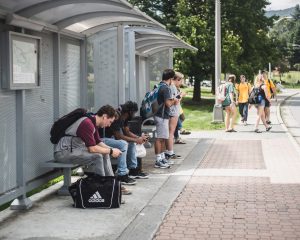OPINION: Lecture classes should be a thing of the past
November 16, 2022
Lecture classes can hold hundreds of students. They can serve several purposes such as teaching higher numbers of students without the need to hire more professors. However, there are more reasons why large lecture classes should be a thing of the past. In an environment with that many students, most professors do not take attendance. Generally, larger class sizes lead to disengagement, low attendance and grades and providing difficulties for students with neurodiversity and other disabilities. It’s an out-of-date education style. Not to mention the expansion of the university, lecture classes are only scheduled to get bigger and more out of control, with over 20,000 students enrolling in fall 2022.
In IG Greer lecture halls, professors often can’t see part of their class. A lack of visual attention can lead to disengagement and disinterest, leading more and more students to flunk out of class. Furthermore, professors usually don’t take attendance in larger classes, or have virtual attendance accessibility outside of the class. Despite the many resources created to make life easier while navigating college, they don’t help at all when many students aren’t inclined to attend class. Many lecture classes are taught with presentations that will be posted online or material straight from the textbook. With class material readily available, it’s difficult to find a reason to get up and be ready to cram into a packed auditorium for an hour.
In smaller classes, it’s easier for professors to establish a connection with their students. They can address individual students and their struggles without taking away from instruction, as well as encourage students to attend lessons. Larger classes have generated a need for many resources to help professors cope with the challenges of teaching that many students at once. Some official universities themselves have even published some of these resources. However, this is simply a way of making the best of a bad situation. Even with the best of professors, lecture halls are likely to have low attendance and grade averages.
All of this goes without considering the spread of illnesses within these classes. Containing exposure becomes much more complicated with hundreds of students packed together. This is especially dangerous as people try to forget the past few years. Even now, where masks have become relatively uncommon, there were over 7,900 new cases reported in North Carolina the week of Nov. 5. About 600 of the cases from that week resulted in hospitalizations. While we’ve lowered the number of cases and serious consequences from COVID-19, the United States still has one of the highest case counts globally.
Many universities have already done away with lecture classes. Research has shown that large lectures are unproductive for retaining information and learning, the primary goal for a college course. Other goals of in-person learning can be creating community, building social skills and learning from your peers, none of which is necessarily possible within large lecture halls. Lack of student connection can be especially harmful when you consider that most lecture halls are introductory subjects, a time when it may be important to retain information in order to build a solid foundation of knowledge for higher level classes. Lecture halls also tend to be faster-paced, leaving less time to take traditional notes. You’ll notice many students typing away on their laptops, simply because this is more efficient. However, it has been proven that physically writing notes helps commit the information to long-term memory.
On top of all this, larger lectures can also be harmful to students with neurodivergence or learning disabilities. Expecting differently-minded students to go about learning in the same way as neurotypical students, students deemed to function as what society deems normal, is not exactly a helpful mindset. An article published by Harvard Health discusses neurodivergence and how neurodivergent people can struggle in society, which further establishes the extra help they need. In many classes, there are opportunities and room for students who learn differently to get help or look at the material differently, however, this is almost impossible in larger classes. Even guidelines on how to work with neurodivergent students, such as the ones published by the National Autism Society, tend to be difficult in this setting. Even office hours are difficult resources to use when there’s only time to see professors at niche times that might not be available to some students based on their schedule. This is almost certainly setting neurodivergent students up for failure.
It seems the time has come for lecture halls to take their place in history. The university needs more full-time professors and downsizing of classes. Part of this should include better treatment and benefits for professors, as well as more flexibility with their coursework. Lectures date back to ancient Greece and Rome and have been in use since then. However, in that time, the understanding of the human mind and how people learn has advanced greatly, so it’s time to accommodate that with schooling. After all, most of the practices from ancient societies have been done away with due to advancements in knowledge and technology. Why not try to improve something as important as education?










